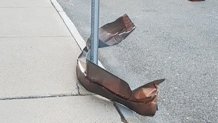Bob Driscoll sat at a picnic table outside City Hall and said he loved his career with the Melrose Fire Department before recently retiring after more than 20 years on the job.
But living and working at the city’s fire stations while waiting for the next emergency call? That’s another story.
WATCH ANYTIME FOR FREE
Stream NBC10 Boston news for free, 24/7, wherever you are. |
“I’ve been on deployments with the military and had better working conditions,” Driscoll said. “The conditions inside the fire stations are deplorable.”
Could it really be that bad?
Get updates on what's happening in Boston to your inbox. Sign up for our News Headlines newsletter.
After receiving a “Small Town Secrets” tip from a viewer, the NBC10 Investigators submitted a public records request for documents related to the city’s three fire stations.
The 300-plus pages of emails and other records we received from the past two years did not paint a pretty picture.
Problems included: leaks from the dilapidated roof and gutters; rodent infestation and mouse dropping on kitchen counters; dead animals and “horrible” odors coming from the boarded-up hose tower; and leaking urinals discharging raw sewage into the basement.
Investigations
In a November 2022 email, Fire Chief Ed Collina reported a standing puddle of liquid in the basement of the Tremont Street station and said it “smells like a stairway in a parking garage next to the Garden.”
In an email last January, a firefighter wrote to Collina: “I just wanted to make you aware that today I found mice droppings in my locker all over my personal belongings, including my change of uniform and bedding.”
After reviewing the documents, we reached out to Collina, who agreed to give us a tour of the department headquarters, built at the turn of the century in 1895 and designed for horse and carriage fire apparatus.
The emails we reviewed show Collina spends a good chunk of his time letting the DPW and other city leaders know about the latest problem that needs fixing.
On some summer days, the chief reported temperatures rising above 80 degrees in the living quarters. During the winter, temperatures sometimes fell below state-mandated levels required to preserve medication on ambulances, according to the emails.
Photos Show Deteriorated Conditions at Melrose Fire Department Properties
During our visit earlier this month, many of the issues at the headquarters were hard to miss, like the mouse traps lining the hallways.
“I think there’s more rodents than manpower here,” Collina quipped.
In the department office, a blue plastic pool sat on a table, positioned to catch leaks from the ceiling. Along the kitchen floor, tile appeared to be disintegrating away, leaving large chunks missing.
“Disgusting,” Collina said. “You wouldn’t put up with this in your home.”
Down in the basement, large cracks and concrete chunks provided evidence the floor is literally falling apart.
A section of the main floor had to be condemned more than a decade ago. It’s now held up by temporary shoring and can no longer support the weight of a parked fire truck or ambulance.
“If this fails, we are out of business,” Collina said, referencing the temporary piers.
We took the list of issues to Melrose Mayor Paul Brodeur and asked how he feels about first responders operating in those conditions.
“It’s very frustrating,” Brodeur responded. “It’s not fair or correct to ask people to work in a workplace that by many measures, is not up to snuff.”
“They are safe. I will say that,” Brodeur added.
However, time after time, the records we reviewed raised safety concerns.
An inspection of the slate roof warned of pieces of tile falling and hitting someone on the ground below. On Christmas Eve, high winds dislodged a piece of metal flashing and wrapped it around a nearby street sign.

One email last September expressed concern about a ceiling collapse from water damage: “If the ceiling comes down and injures a firefighter, it would be an unnecessary injury because we knew of the problem.”
Another message in July 2021 worried about flooding or rodents wiping out the wiring that operates the building’s communications system: “Any failure of these could result in catastrophic failure of public safety services in a time of need.”
When asked about the safety-related emails we obtained, Brodeur said, “If (the buildings) were not safe, I wouldn’t sent folks in. We would have to look at alternatives.”
The mayor is in the midst of looking at long-term alternatives. In October 2021, he appointed a committee that will study and recommend the best strategy to bring the aging public safety facilities into the 20th century (the police station building also dates back to 1900).
On Wednesday, the city launched the Public Safety Building Committee website, which includes information about plans to renovate city buildings.
The solution will undoubtedly require a significant investment from taxpayers. A similar committee under a previous administration stalled after failing to reach a consensus on the best approach.
“We have to do something,” Brodeur said. “We have no more time to wait.”
Until then, the plan seems to be something first responders know a lot about: triage and hope for the best.
“Our public safety personnel deserve better conditions to live in and work in,” Driscoll said.
Ryan Kath can be reached at ryan.kath@nbcuni.com. You can follow him on Twitter or connect on Facebook.



